Swabian maultaschen (or literally “pockets”) are a local German delicacy that you’ve probably never heard of. Although it’s common fare in the Swabia region of Germany, it is relatively unknown outside of the area around Stuttgart.
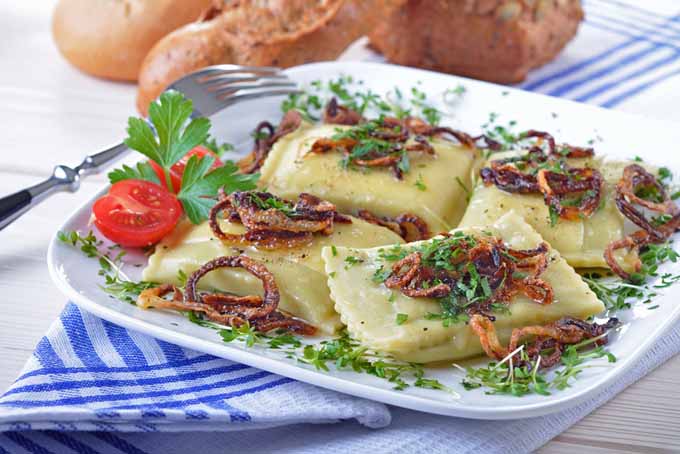
A savory meat-and-spinach filling is wrapped in delicious pasta dough, and then cut into appealing pockets. A touch of freshly ground nutmeg adds an unexpected but totally pleasant bit of spice. Enjoy them plain, roasted, or as an addition to your vegetable soup.
When it comes to local specialties, Swabian cuisine has a lot to offer. There are many recipes that derive from this region, and Swabia is known throughout the German-speaking region of Central Europe as a foodie hotspot.
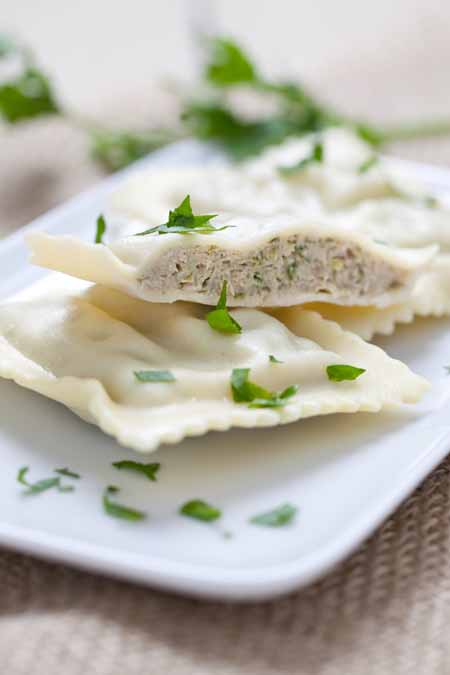
If you have read about Swabian Spaetzle, you might remember the distinct history and tradition connected with that recipe. This dish also has a story behind its name that is worth being told.
If you look at a whole “pocket,” you can’t see what’s inside and you don’t know for sure what you are about to eat. It is said that this was an important fact for the monks of the Cistercian Monastery in Maulbronn.
The monks developed this meal to eat during various fasting periods, and hid the meat in the pocket’s dough so that God could not see their secret filling. I would describe this as a fairly clever idea, not without a big pinch of cheekiness.
Well, one has to admit that the idea of filling pasta dough with meat or vegetable isn’t completely new. Just think about Italian ravioli or tortellini.
If you then consider that religious refugees from Northern Italy were living in area surrounding the Maulbronn Monastery, it’s possible that they could in fact be of Italian origin.
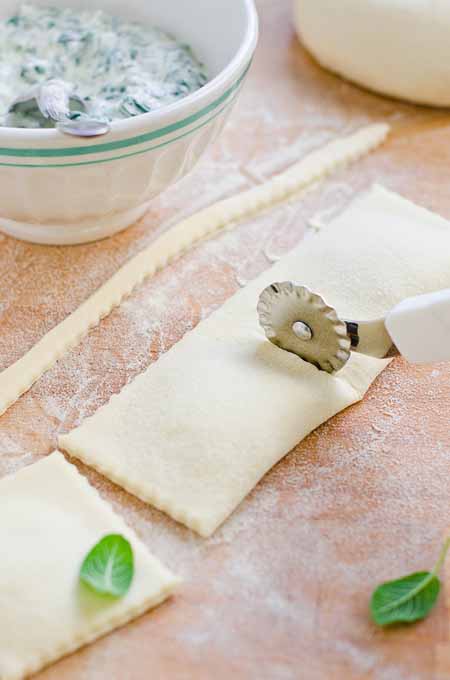
There are different variations of how to serve them, and of course you are not bound to these ideas and can create your very own pocket dish however you like.
One possibility is to add them to your vegetable soup or broth like a potsticker. Another idea is to either roast the whole pockets in butter and serve with roasted onions, or slice them up and then roast the pieces.
If you can’t eat all of the pockets that you produce using the recipe outlined below, you can freeze them and use them as needed. Also, you may be creative when it comes to the filling. Try a vegetarian version with pureed vegetables or hummus instead of the ground meat. Either way, you’ll need a blender or a food processor to speed up the process.
- 2 cups flour
- 2 eggs
- 2 tablespoons Oil
- Salt and pepper to taste
- 2/3 cup frozen chopped spinach thawed
- 3 onions
- 1/2 pound ground meat
- 2 tablespoons breadcrumbs
- freshly ground nutmeg
- Mix the flour, ½ teaspoon salt, eggs, oil and 3 tablespoons of water and knead to a smooth dough. Cover with a moist kitchen towel and let rise for 20 minutes at room temperature.
- Peel and dice one onion.
- Use a blender to mix spinach, the onion, ground meat, breadcrumbs, salt, pepper and nutmeg.
- Take the dough and roll out rectangular pieces, as thin as possible. With the help of two teaspoons, spread the mixture bit by bit with some distance on the upper half of the dough. Coat the space in between with some water or egg so that everything can stick together later.
- Fold the lower half over the upper part and press between the small heaps of filling.
- Take a pastry wheel or a knife and cut pockets out of the dough. Press the edges again so that the filling won’t ooze out when cooking.
- Bring either salted water or vegetable stock to boil. Let the pockets simmer at middle heat for about 10-15 minutes.
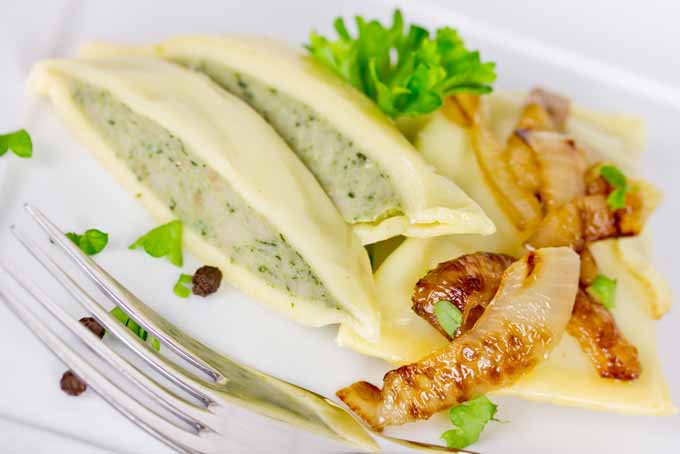
For more homemade pasta recipes, get ready to flour your counter and make these:
About Nina-Kristin Isensee
Nina lives in Iserlohn, Germany and holds an MA in Art History (Medieval and Renaissance Studies). She is currently working as a freelance writer in various fields. She enjoys travel, photography, cooking, and baking. Nina tries to cook from scratch every day when she has the time and enjoys trying out new spices and ingredients, as well as surprising her family with new cake creations.

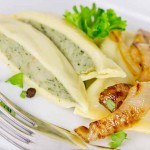


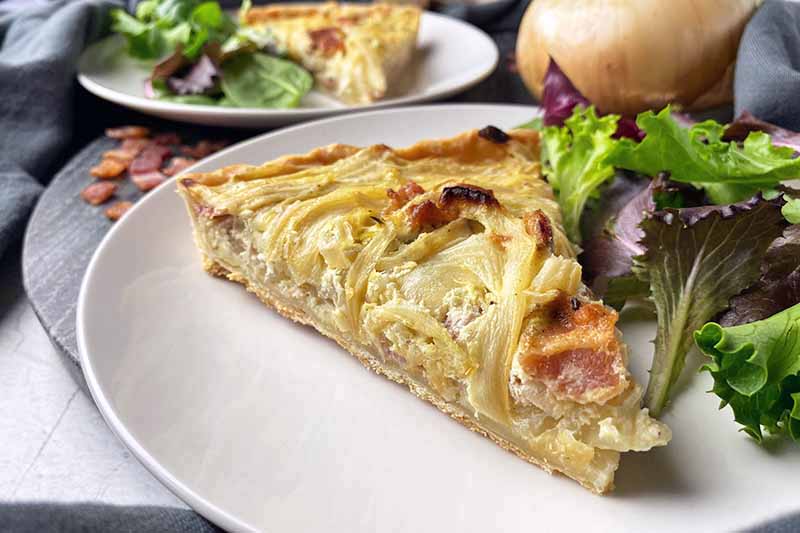
Nice to know German food has something for vegetarians. The pockets are like big raviolis and seem versatile as a dish by themselves or as you say to add in soup if you make them smaller. I like to eat them with some flavored oil and black pepper, simple and so the pockets don’t get too dry.
While this looks a really good, I think I’ll try substituting the meat for some sort of corn or vegetarian product. It’d be good to test out I think, although the vegitarian or hummus version does sound good, I like using similar textured substitute.
Its very rare to find vegitarian German foods, but when I do, they’re usually really tasty!
Thank you for sharing!
Traditional German cuisine indeed often includes meat and most of the well-known recipes are somehow rustic. Today, things have changed a bit and many restaurants serve authentic vegetarian and vegan recipes that still have a traditional twist. As I see it, especially Mediterranean cuisine has influenced the current German way of eating.
So, I hope you enjoy this meat-free version of the pockets!
Well what do you know, here’s another recipe to add to my ever growing list of ones to try out. This swabian maultaschen looks incredible. I bet it would taste great with a bit of cheese sprinkled or melted on top! This is a really neat dish because it seems like something you could make big in strips or smaller, bite-sized pieces like ‘normal’ pastas. It also leaves a good amount of room for experimenting with different ingredients, too! I think in this case I’d replace the onions with some sort of chopped up pepper since I’m not an onion fan. Thanks for the tasty recipe, Nina!
Yum, I love the idea of hiding the contents, and spinach is always a favorite of mine. Your directions sounds easy to follow, and I do have a pastry cutter, so will hopefully be trying out this recipe soon. I’d never have thought of cooking them in vegetable stock, so I’m glad you mentioned that, as it will add another dimension to the flavor.
I made this recipe today. My dumplings look awful. But taste ???? Thanks for the recipe.
I like the idea of these, but I would got for a pure meat filling and not bother with the spinach, as I find it rather bland. I can’t quite resolve myself to the idea of dunking them in soup, though, and the idea of eating ‘soft’ dough without some kind of sauce doesn’t appeal to me, so I would more than likely end up with them covered in a tomato-based sauce – much the same as a standard ravioli!
Sure, you can leave the spinach out if you like. And tomato-sauce is a nice way to have them with. Another suggestion for you – as you don’t like to eat them in broth – would be to leave them to cool, slice and fry them in a pan. This provides a nice crispy outside and I like the roasting-flavors. As a part of stir-fries, or even a salad, they work well this way, too.
Hello, you are not dunking them- they are served and eaten in the broth!!! And there is nothing better on earth! I lived in many places and countries, and it’s really true! Short of stuffing them with seal meat in the Arctic – I tried and ate many variants. And btw, German cooking was almost meat-free in the many hard years after the war, believe me!
My mother and our neighbor, another German woman, would prepare Maultashen a few times a year in huge quantities. It took two days. They would grind their own meats including pork brains and prepare the filling on the first day do it could ferment overnight. The second day they would make the pasta and fill the pockets. They would freeze a ton and serve about once a week They always said it was the old correct way to make Maultaschen.. I saw this happen many times but never got the recipe. This stuff was to die for. Do you know of any old recipes utilizing pork brains and a night of fermentation?
Thanks for your story! Unfortunately, I have to admit that I don’t know a specific recipe which uses pork brains or the fermentation. I did some research on that and it seems like this was a more common procedure in earlier times – when people would use all parts of the animal, instead of just the “fine” parts, today, like tenderloin or so.
And as Maultaschen are very traditional, this might have been popular. It would be interesting to know if your neighbour came from Swabia, the region where this dish is most popular.
Still, thank you for the info, I wasn’t aware of this before either 🙂
Do you remember where your mother was from? I would LOVE to follow that recipe! Though I have been unable to get any brains in Canada!!!! I would welcome your reply.
Contact a hog farmer or slaughter house
This recipe makes me think of a Chinese soup with little dimsum in it. I forgot the name of the soup, but it’s a noodle soup using either beef or chicken stock. They add there a dimsum-like dish, similar to this one. The only difference is instead of this rectangular shape, they’re formed into balls.
Can these pockets be fried and eaten as snacks? I just thought it looks like a version of empanada when deep-fried. Of course, the fillings are different. Just a thought.
I know what kind of soup you mean, that is indeed the Asian way of this version it seems.
I like your idea of turning the pockets into fried snacks, thanks for the tip! I’m sure that will work out great – yummy 🙂
I cut them into strips and gently fry to heat, then pour one stirred egg over and gently cook till hot. The other option is to heat in stock. Had some today – very yum.
As soon as I saw this article I thought of pierogiess! I am a Pittburgh native, so pierogies are everywhere. I have to think that swabian pockets share some similarities to their Polish neighbors. These seem like a nice change of pace when I want a lighter meal, but still want some of that European homestyle meal. The stuffing possibilities are endless. Thanks for making me aware of this unknown gem of a dish!
I know what kind of “pockets” you’re talking about, I agree with you about their similar qualities. You’re right about the countless variations you can create with these, I hope you have fun making your very own tasty mix 🙂
I have had German Maultaschen before while living in a boarding school in South Germany.
However, I never knew how to make them. I am very excited to give it a try and make them myself and see if my kids like it as much as I do!
Great, that’s interesting. They are quite a national dish in the Southern part of the country, so no wonder you came in contact with them 🙂
I hope you have success when you try them and that your kids like the little pockets! Enjoy!
Thank you for sharing this with us. This sounds like a perfect dish for me to make. My pickiest eater likes spinach of all things, and she really likes pasta of all kinds. This should be a great addition to our family menu. I think the rest of us will enjoy it too.
I like making food that presents well also, and this looks great too. Good to know that it freezes well, so thanks for that little tip as well.
Nice, then I hope these little pockets will be a success at home. As I see it, the combination of spinach and dough (like pasta or pastry) is always a winner. Hope you enjoy it!
I do love the history behind this dish, but it does look a bit unappetising to me, without lashings of lovely tomato sauce.
Do you think? Unfortunately there is no way to capture the flavor in photos, too 😉 Anyway, they will definitely go well with some tomato sauce – but some kind of creamy and cheesy sauces are a nice choice, too. Thanks for reading the article, I think it’s always interesting to get to know the story behind a dish – especially when it’s so unique like this.
Give it a try!
I was never very convinced by clear broths but a stay in Stuttgart decades ago introduced me to Maultaschen and a variety of ‘Einlagen’ for soups – converted me totally. Just make sure you use a tasty stock and think of them as dumplings rather than ravioli, if that helps! (And they are so moist that the fried version with the onions doesn’t need sauce.)
Had this in Germany in 2006, during Christmas market season. My son said it was “Fest Food”. We spent 3 months with him. It was the only time I saw maultaschen. Our son married a girl from a town near Stuttgart. Her grandmother is from Swaibush Hall (Swaibia). They are coming to visit in March. She is bringing me about 50. I love them.
Well leave it to the Germans to come up with these delicious things and then have the strangest names for them so that it makes it hard for me to recognize and remember. I did get a quick laugh at seeing that it was undiscovered, and I cannot help but think that the name has something to do with it. That said, though, it looks delicious and something that I will have to keep in mind. Thanks for sharing.
The vegetarian version sounds delightful! They seem like a cross between ravioli and Polish pierogis. They look like they would also be a nice addition to a vegetable or chicken stew. I like the idea of eating them with hummus, too, so it looks like there are a lot of variations to try!
I tried pronouncing that.. it didn’t go too well. These Swabian Pockets surely taste amazing although they’re not the most appealing in terms of looks. As HappyKoi mentioned, the vegetarian version sounds really good as well!
I lived in Stuttgart from 1971-78 and we would slice these, fry them briefly then crack scrambled eggs over them and eat with ketchup. Heaven! I’ve made them recently with ready made wonton wrappers and they’re great. You have to boil them first of course.
You all don’t know real Schwäbisch food. This is my childhood. They are always served in a broth beef or chicken and topped with sautéed onions and potato salad on the side. If you want to have a tomato sauce with it just have ravioli. If you don’t like spinach leave it out.
I agree. Tomatoes just don’t do it with Maultaschen. It is German, not Italian.
Ever since I moved back to the US from Germany I’ve been looking for a recipe for these! I’m so happy to find it! Thank you for sharing!
You’re welcome! Enjoy!
Hello ! My Oma taught my younger sister how to make her version of this, and it was the stuffing that, for me, made it delish !! She used ground pork/garlic/fresh parsley as the main ingredients for hers. My sister has been patient with me when we’ve gotten together to make large batches to freeze. We prefer the frying of the Maultaschen with a dab of sour cream on top for dinners! My main issue has always been the dough, but you’ve shown that your recipe is quite easy to make, and i may be surprising my sister with my attempt! lol…
Also, have you ever heard of Schupfnoodle(?) using leftover boiled potatoes? They make a great side dish as well to the Maultaschen for supper !
Thx for your attention!
Frank
Thanks so much for sharing, Frank. I am familiar with Schupfnoodle – yum! I hope you and your sister enjoy the recipe.